The NVIDIA GeForce GTX 750 Ti and GTX 750 Review: Maxwell Makes Its Move
by Ryan Smith & Ganesh T S on February 18, 2014 9:00 AM ESTPower, Temperature, & Noise
As always, last but not least is our look at power, temperature, and noise. Next to price and performance of course, these are some of the most important aspects of a GPU, due in large part to the impact of noise. All things considered, a loud card is undesirable unless there’s a sufficiently good reason – or sufficiently good performance – to ignore the noise.
| GeForce GTX 750 Series Voltages | ||||
| Ref GTX 750 Ti Boost Voltage | Zotac GTX 750 Ti Boost Voltage | Zotac GTX 750 Boost Voltage | ||
| 1.168v | 1.137v | 1.187v | ||
For those of you keeping track of voltages, you’ll find that the voltages for GM107 as used on the GTX 750 series is not significantly different from the voltages used on GK107. Since we’re looking at a chip that’s built on the same 28nm process as GK107, the voltages needed to drive it to hit the desired frequencies have not changed.
| GeForce GTX 750 Series Average Clockspeeds | |||||
| Ref GTX 750 Ti | Zotac GTX 750 Ti | Zotac GTX 750 | |||
| Max Boost Clock |
1150MHz
|
1175MHz
|
1162MHz
|
||
| Metro: LL |
1150MHz
|
1172MHz
|
1162MHz
|
||
| CoH2 |
1148MHz
|
1172MHz
|
1162MHz
|
||
| Bioshock |
1150MHz
|
1175MHz
|
1162MHz
|
||
| Battlefield 4 |
1150MHz
|
1175MHz
|
1162MHz
|
||
| Crysis 3 |
1149MHz
|
1174MHz
|
1162MHz
|
||
| Crysis: Warhead |
1150MHz
|
1175MHz
|
1162MHz
|
||
| TW: Rome 2 |
1150MHz
|
1175MHz
|
1162MHz
|
||
| Hitman |
1150MHz
|
1175MHz
|
1162MHz
|
||
| GRID 2 |
1150MHz
|
1175MHz
|
1162MHz
|
||
| Furmark |
1006MHz
|
1032MHz
|
1084MHz
|
||
Looking at average clockspeeds, we can see that our cards are essentially free to run at their maximum boost bins, well above their base clockspeed or even their official boost clockspeed. Because these cards operate at such a low TDP cooling is rendered a non-factor in our testbed setup, with all of these cards easily staying in the 60C or lower range, well below the 80C thermal throttle point that GPU Boost 2.0 uses.
As such they are limited only by TDP, which as we can see does make itself felt, but is not a meaningful limitation. Both GTX 750 Ti cards become TDP limited at times while gaming, but only for a refresh period or two, pulling the averages down just slightly. The Zotac GTX 750 on the other hand has no such problem (the power savings of losing an SMX), so it stays at 1162MHz throughout the entire run.

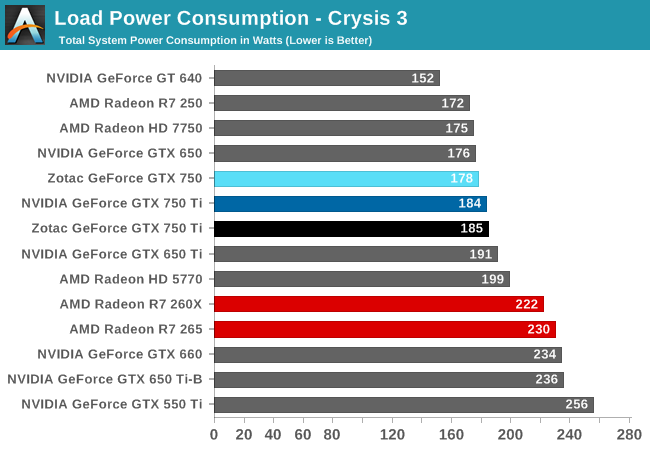
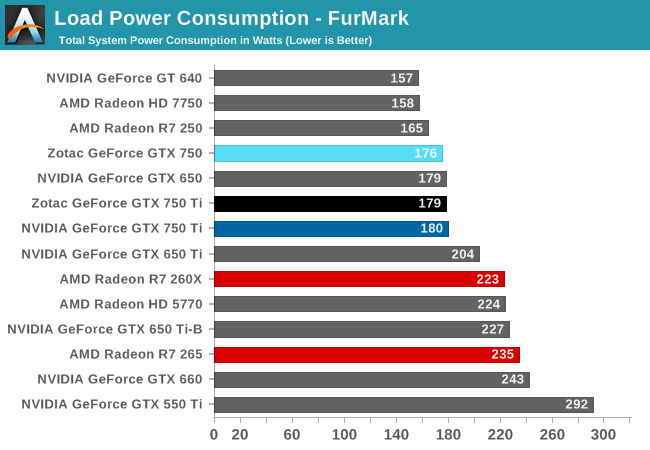


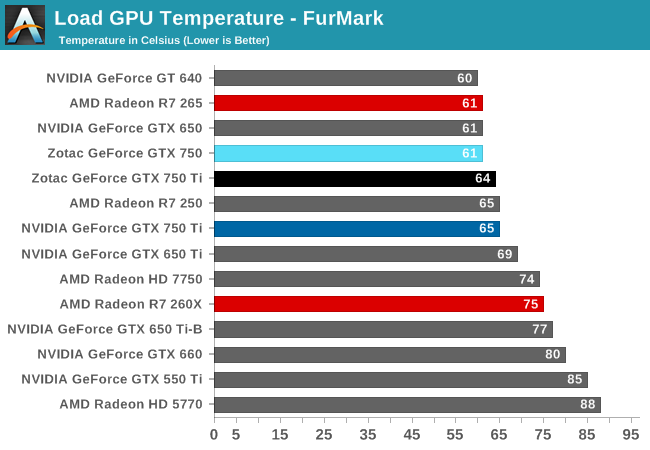
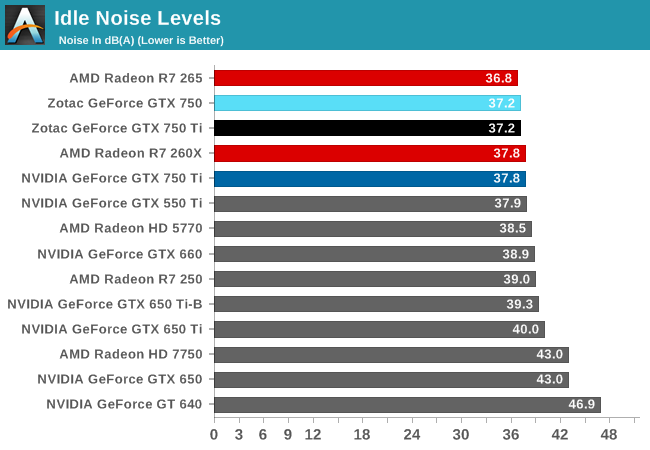
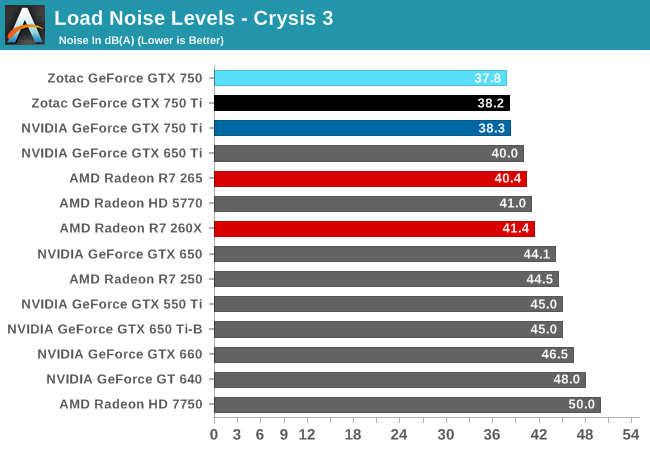
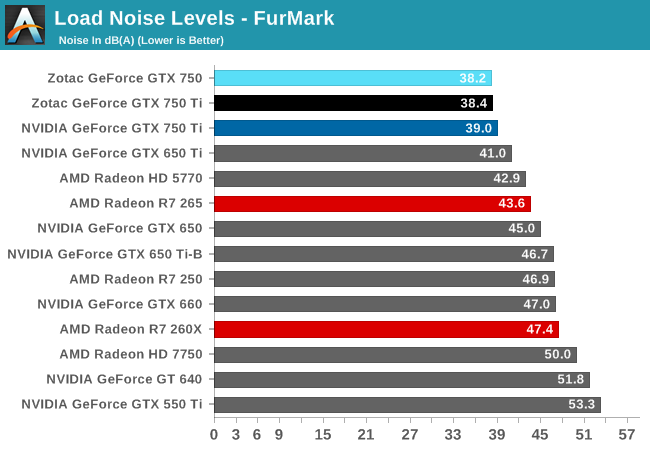










177 Comments
View All Comments
kwrzesien - Tuesday, February 18, 2014 - link
Seems coincidental that Apple is going to use TSMC for all production of the A8 chip with Samsung not ready yet, maybe Apple is getting priority on 20nm? Frankly what nVidia is doing with 28nm is amazing, and if the yields are great on this mature process maybe the price isn't so bad on a big die. Also keep in mind the larger the die the more surface area there is to dissipate heat, Haswell proved that moving to a very dense and small die can create even more thermal limitations.DanNeely - Tuesday, February 18, 2014 - link
Wouldn't surprise me if they are; all the fab companies other than Intel are wailing about the agonizingly high costs of new process transitions and Apple has a history of throwing huge piles of its money into accelerating the build up of supplier production lines in trade for initial access to the output.dylan522p - Tuesday, February 18, 2014 - link
Many rumors point to Apple actually making a huge deal with intel for 14nm on the A8.Mondozai - Wednesday, February 19, 2014 - link
Maybe 14 for the iPhone to get even better power consumption and 20 for the iPad? Or maybe give 14 nm to the premium models of the iPad over the mini to differentiate further and slow/reverse cannibalization.Stargrazer - Tuesday, February 18, 2014 - link
So, what about Unified Virtual Memory?That was supposed to be a major new feature of Maxwell, right? Is it not implemented in the 750s (yet - waiting for drivers?), or is there currently a lack of information about it?
A5 - Tuesday, February 18, 2014 - link
That seems to be a CUDA-focused feature, so they probably aren't talking about it for the 750. I'm guessing it'll come up when the higher-end parts come out.Ryan Smith - Thursday, February 20, 2014 - link
Bingo. This is purely a consumer product; the roadmaps we show are from NV's professional lineup, simply because NV doesn't produce a similar roadmap for their graphics lineup (despite the shared architecture).dragonsqrrl - Tuesday, February 18, 2014 - link
"Meet The Reference GTX 750 Ti & Zotac GTX 750 Series""This is the cooler style that most partners will mimic, as the 60W TDP of the GTX 650 Ti does not require a particularly large cooler"
You mean 750 Ti right?
chizow - Tuesday, February 18, 2014 - link
The performance and efficiency of this chip and Maxwell is nothing short of spectacular given this is still on 28nm. Can't wait to see the rest of the 20nm stack.Ryan, are you going to replace the "Architectural Analysis" at some point? Really looking forward to your deep-dive on that, or is it coming at a later date with the bigger chips?
dgingeri - Tuesday, February 18, 2014 - link
In the conclusion, the writer talks about the advantages of the AMD cards, but after my experiences with my old 4870X2, I'd rather stick with Nvidia, and I know I'm not alone. Has AMD improved their driver quality to a decent level yet?